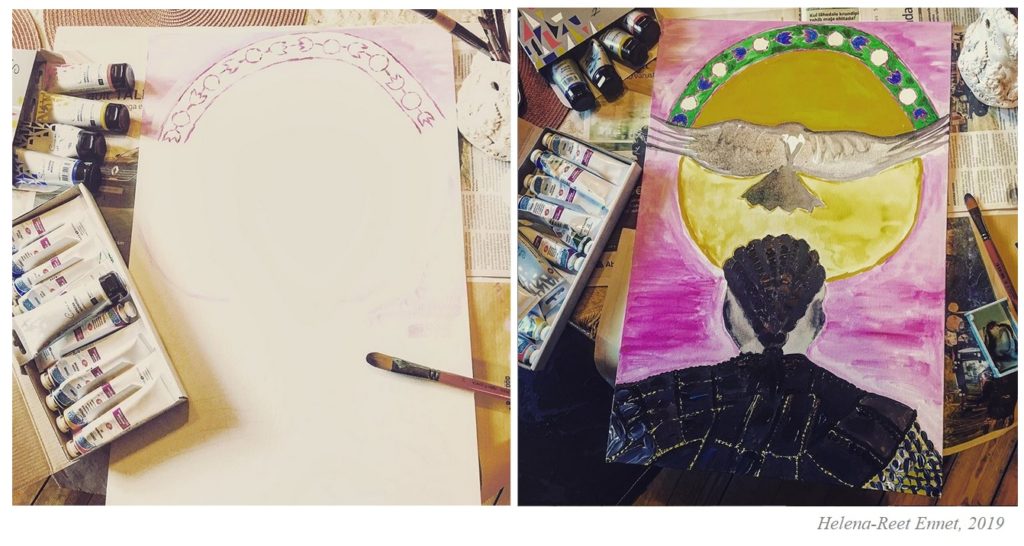
#5 Paintings by Helena-Reet Ennet: “Huginn”, May/June 2019 + HIDDEN SURPRISE!
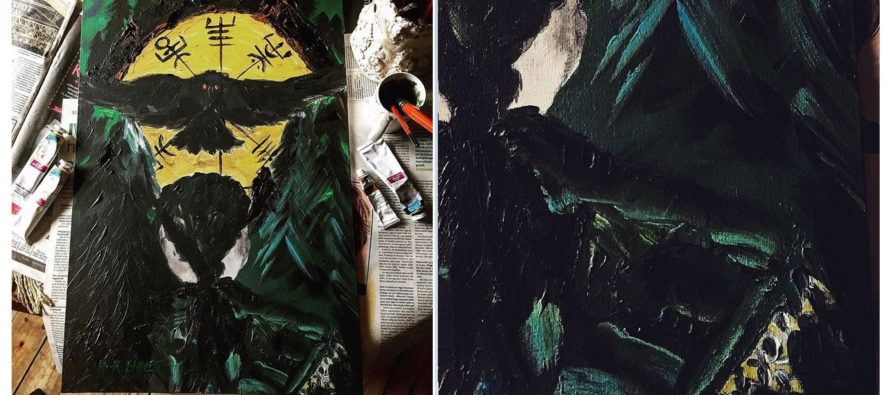
Hi loves.. My acrylic painting “Huginn” is finally ready. And.. I have a surprising fact for you about this picture. This painting symbolizes the sun´s journey (sunrise and sunset) and what you can see in the final picture is sunset with raven Huginn, Bifrost bridge, Viking´s compass (Vegvisir mark), full moon, dark Nordic forest and a north man. The sunrise, sea and folklore symbols are painted under the final painting! Isn´t that cool?! 😛
Huginn – In Norse mythology, Huginn (from Old Norse “thought”) and Muninn (Old Norse “memory” or “mind”) are a pair of ravens that fly all over the world, Midgard, and bring information to the god Odin. Huginn and Muninn are attested in the Poetic Edda, compiled in the 13th century from earlier traditional sources: the Prose Edda and Heimskringla, written in the 13th century by Snorri Sturluson; in the Third Grammatical Treatise, compiled in the 13th century by Óláfr Þórðarson; and in the poetry of skalds. The names of the ravens are sometimes modernly anglicized as Hugin and Munin.
In the Poetic Edda, a disguised Odin expresses that he fears that they may not return from their daily flights. The Prose Edda explains that Odin is referred to as “raven-god” due to his association with Huginn and Muninn. In the Prose Edda and the Third Grammatical Treatise, the two ravens are described as perching on Odin’s shoulders. Heimskringla details that Odin gave Huginn and Muninn the ability to speak.
Migration Period golden bracteates, Vendel era helmet plates, a pair of identical Germanic Iron Age bird-shaped brooches, Viking Age objects depicting a moustached man wearing a helmet, and a portion of the 10th or 11th century Thorwald’s Cross may depict Odin with one of the ravens. Huginn and Muninn’s role as Odin’s messengers has been linked to shamanic practices, the Norse raven banner, general raven symbolism among the Germanic peoples, and the Norse concepts of the fylgja and the hamingja.
Bifrost – In Norse mythology, Bifröst (or sometimes Bilröst or Bivrost) is a burning rainbow bridge that reaches between Midgard (Earth) and Asgard, the realm of the gods. The bridge is attested as Bilröst in the Poetic Edda; compiled in the 13th century from earlier traditional sources, and as Bifröst in the Prose Edda; written in the 13th century by Snorri Sturluson, and in the poetry of skalds. Both the Poetic Edda and the Prose Edda alternately refer to the bridge as Ásbrú (Old Norse “Æsir’s bridge”).
According to the Prose Edda, the bridge ends in heaven at Himinbjörg, the residence of the god Heimdallr, who guards it from the jötnar. The bridge’s destruction during Ragnarök by the forces of Muspell is foretold. Scholars have proposed that the bridge may have originally represented the Milky Way and have noted parallels between the bridge and another bridge in Norse mythology, Gjallarbrú.
Vegvisir – A vegvísir (Icelandic for sign post or wayfinder) is an Icelandic magical stave intended to help the bearer find their way through rough weather. The symbol is attested in the Huld Manuscript, collected in Iceland by Geir Vigfusson in 1880 (but consisting of material of earlier origin).
A leaf of the manuscript provides an image of the vegvísir, gives its name, and, in prose, declares that “if this sign is carried, one will never lose one’s way in storms or bad weather, even when the way is not known”
—
Hei armsad.. Minu akrüülmaal nimega “Huginn” on lõpuks valmis. Ja mul on selle kohta rääkida ka üks põnev fakt. Maal sümboliseerib päikese teekonda (päikesetõusu ja päikseloojangut) ning see, mida te valmis maalil näete on päikeseloojang koos ronk Huginn´i, Bifrosti silla, Viikingite kompassi (Vegvisir), täiskuu, tumeda põhjamaise metsa ja Põhjala mehega. Päiksetõus, meri ja sümbolid folkloorist on joonistatud valmis maali alla! Kas pole lahe?! 😛
Huginn – Huginn (“Mõte”) ja Muninn (“Mälu”) olid Skandinaavia mütoloogias Odini kaarnad, kelle ta saatis igal hommikul välja, et teada, mis kõigis üheksas maailmas toimub. Seejärel pidid nad naasma Odini õlgadele puhkama ja talle nähtust jutustama.
Bifrost – Bifrost on Norra/Põhjamaade mütoloogia järgi sild kõrgel taevamägedel, mille juures elab valvur Heimdall, kes on alati ärkvel. Bifrosti sillaks nimetati taevast ja maad ühendavat vikerkaart.
Vegvisir – Vegvísir on iidne sümbol, mida tuntakse kõige sagedamini ruunikompassina ehk Viikingite kompassina. Otsetõlkes tähendab sümboli islandipärane nimetus “teeviita” või “teetähist”. Vegvisir ise koosneb kaheksast Viikingite maagilisest liitruunist (sigil). Liitruune (sõltuvalt kombinatsioonist) kasutati ning kasutatakse ka tänapäeval ruunimaagias kinglatel eesmärkidel – teatud sündmuste loomiseks, mingite omaduste võimendamiseks või kaitseks.
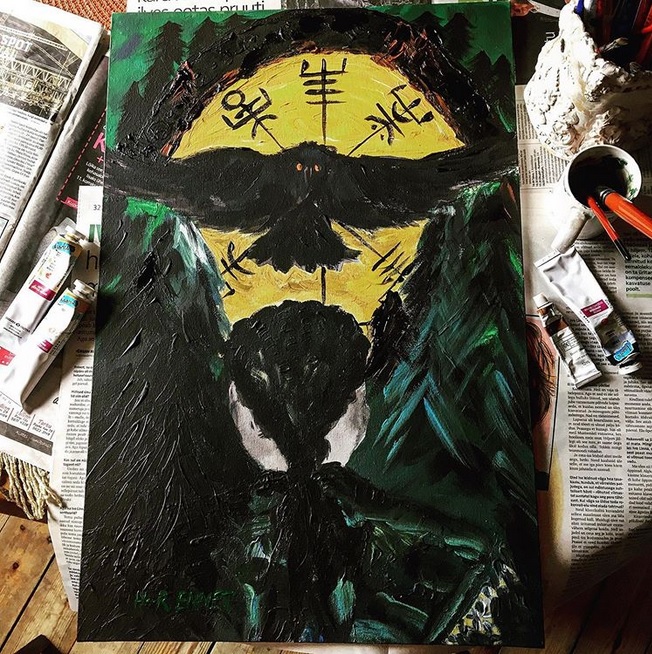
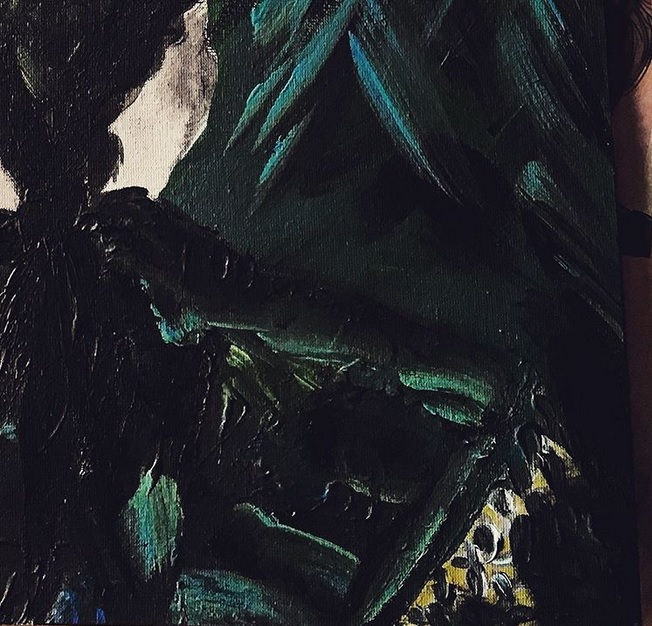
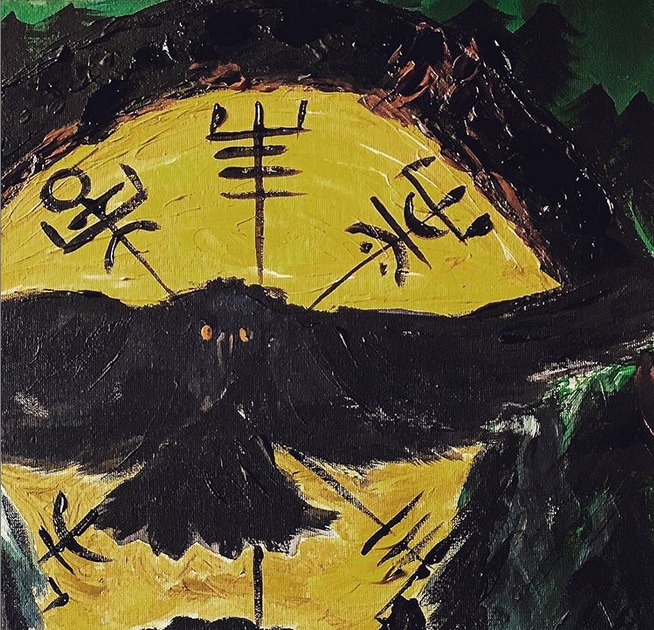
And here you can see, how all this started… and what is hidden under the final painting 🙂
Ja siit te näete, kuidas kõik algas… ning mis on peidus valmis maali all
